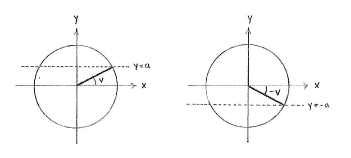Solution 4.3:3a
From Förberedande kurs i matematik 1
(Difference between revisions)
m |
|||
| Line 1: | Line 1: | ||
| - | The angle | + | The angle <math>-v</math> is the reflection of the angle <math>v</math> in the ''x''-axis, and under such reflection the ''x''-coordinate does not change, whereas the ''y''-coordinate changes sign. This means that if <math>\sin v = a\,</math>, then <math>\sin (-v) = -a\,</math>. |
| - | <math>-v | + | |
| - | is the reflection of the angle | + | |
| - | <math>v</math> | + | |
| - | in the | + | |
| - | + | ||
| - | -axis, and under such reflection the | + | |
| - | + | ||
| - | -coordinate does not change, whereas the | + | |
| - | + | ||
| - | -coordinate changes sign. This means that if | + | |
| - | <math>\ | + | |
| - | <math>\ | + | |
| - | + | ||
| - | + | ||
[[Image:4_3_3_a.gif|center]] | [[Image:4_3_3_a.gif|center]] | ||
Current revision
The angle \displaystyle -v is the reflection of the angle \displaystyle v in the x-axis, and under such reflection the x-coordinate does not change, whereas the y-coordinate changes sign. This means that if \displaystyle \sin v = a\,, then \displaystyle \sin (-v) = -a\,.

